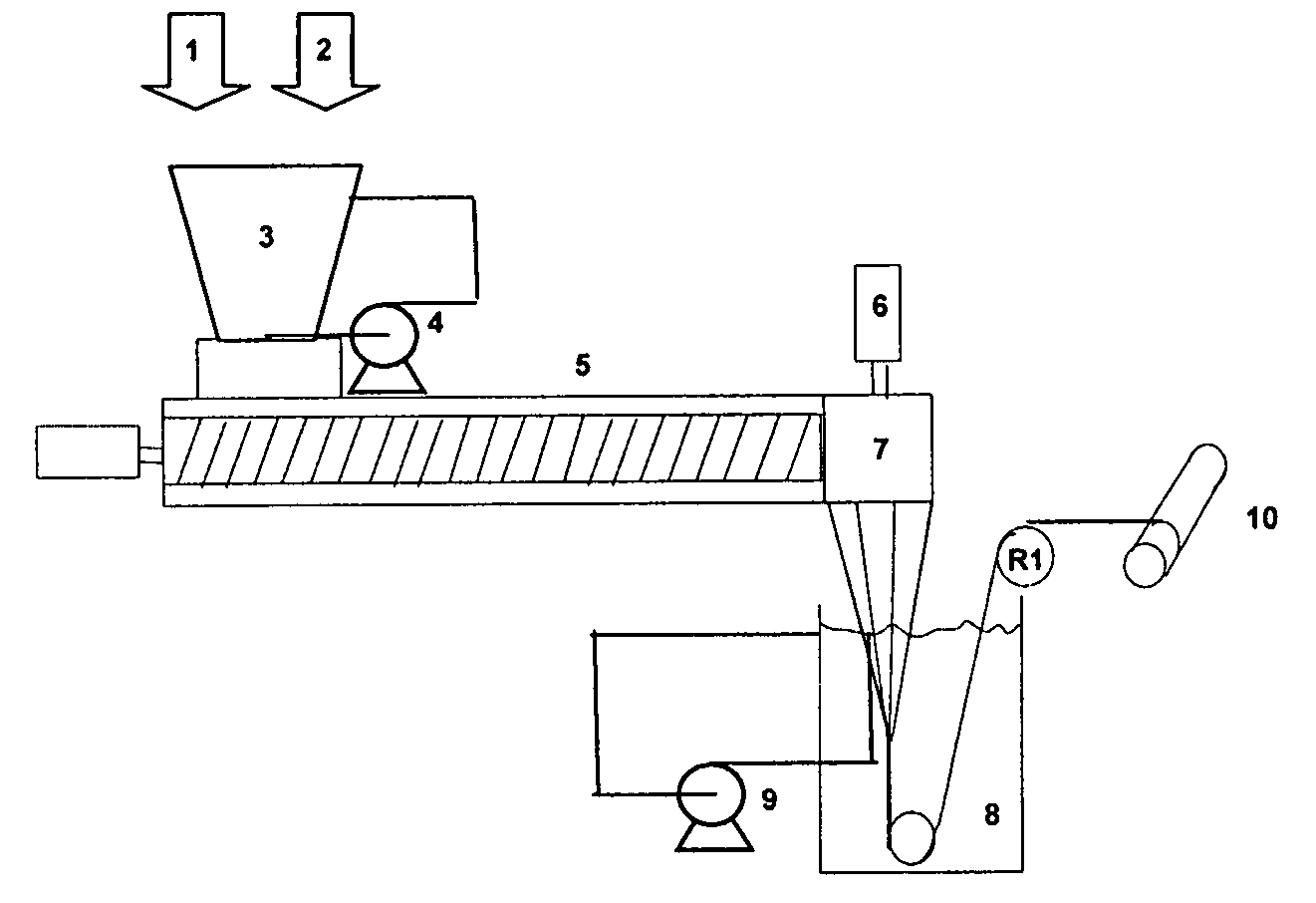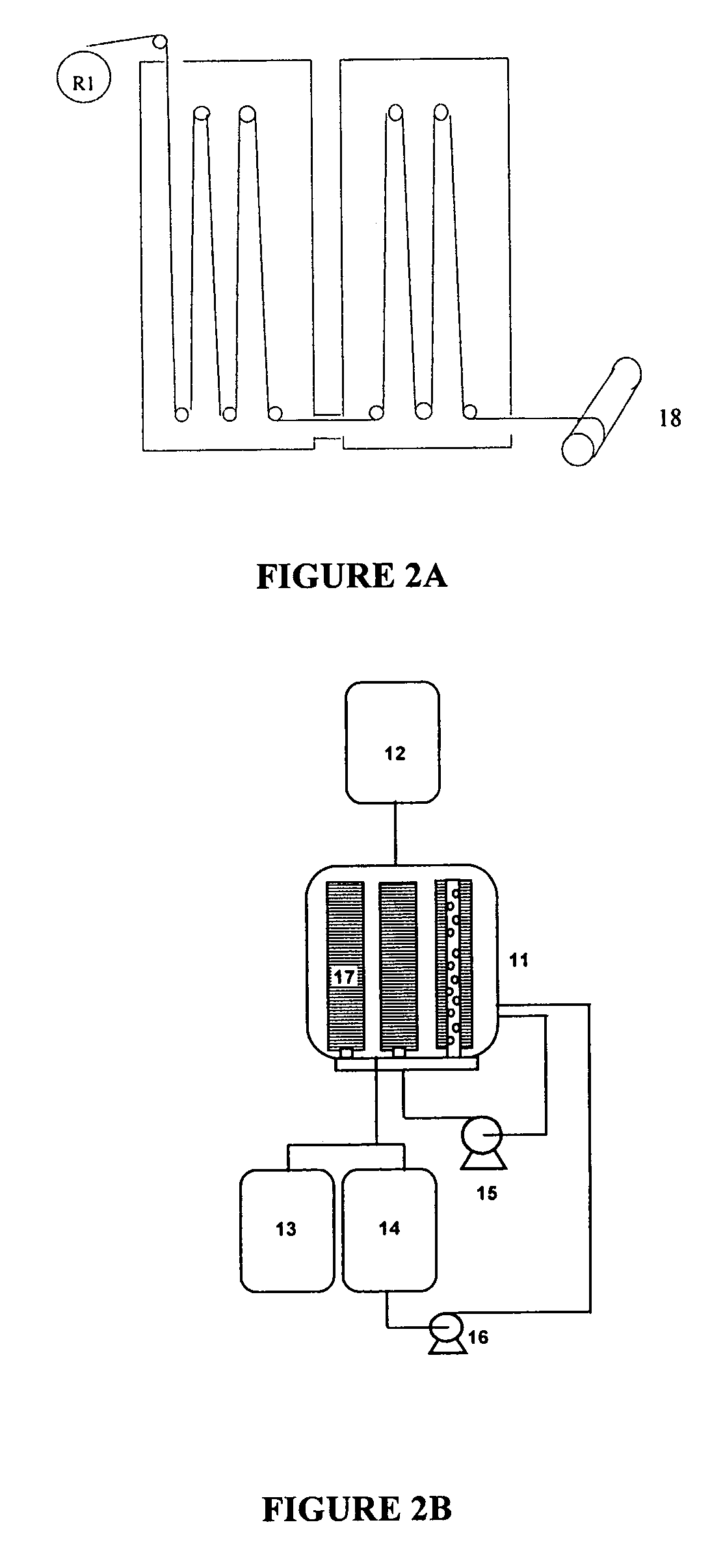Process for the preparation of polymer yarns from ultra high molecular weight homopolymers or copolymers, polymer yarns, molded polymer parts, and the use of polymer yarns
a technology of polymer yarn and homopolymer, which is applied in the field of polymer yarn preparation from ultra high molecular weight homopolymers or copolymers, polymer yarns, molded polymer parts, etc., can solve the inconvenience of using relatively toxic solvents, increase occupational hazards and explosion risks, and increase the risk of explosion
- Summary
- Abstract
- Description
- Claims
- Application Information
AI Technical Summary
Benefits of technology
Problems solved by technology
Method used
Image
Examples
examples 2 and 3
Monomodal Polyethylene A
[0106]Two suspensions, each containing 10% and 12%, by weight, of the same ultra high molecular weight polyethylene as in Example 1, and 90% and 88%, by weight, of a paraffinic mineral oil were prepared.
[0107]The same spinning procedure as described in Example 1 was followed in Examples 2 and 3.
[0108]Yarns with the following characteristics were obtained in Example 2, where polymer concentration was 10%, by weight:
[0109]
Linear Density:117 denierTenacity:30.0 cN / denierElongation (rupture):5%DPF:5.8
[0110]Yarns with the following characteristics were obtained in Example 3, where polymer concentration was 12%, by weight:
[0111]
Linear Density:126 denierTenacity:29.3 cN / denierElongation (rupture):4.7%DPF:6.3
[0112]A small increase in yarn thickness and a slight decrease in yarn tenacity are observed as gel polymer concentrations increase. It was not possible to process a gel with higher polymer concentrations in the conditions described above. The use of bimodal poly...
examples 4 to 6
Monomodal Polyethylene B
[0113]Suspensions respectively containing 8%, 12% and 15%, by weight, of UHMW PE, and 92%, 88% and 85%, by weight, of a paraffinic mineral oil were prepared. The polymer used has an intrinsic viscosity of 28 dl / g and polydispersivity equal to 4.5. The same spinning, extraction and stretching procedures, as described in Example 1, were used. The properties of the yarn thus obtained are shown in Table 1.
[0114]
TABLE 1Properties of the yarn produced with different concentrations of highweight monomodal UHMW PEFilamentYarn LinearLinearDensityTenacityElongationDensityEx.Polymer %(denier)(cN / denier)(%)(DPF)4811033.85.55.551219023.25.19.561531213.35.115.6
[0115]Monomodal type polymer, with a higher molecular weight, is even more difficult to process. In lower concentrations, such as 8% polymer, the molecules manage to align themselves forming a high tenacity yarn, however, at 12% polymer, the formation of the gel is difficult and the resulting yarn is hardly stretchab...
example 7
Bimodal Polyethylene A
[0117]A suspension comprising 15%, by weight, of UHMW PE, and 85%, by weight, paraffinic mineral oil was prepared for Example 7. The linear polyethylene has a bimodal molecular weight, 12 dl / g intrinsic viscosity and polydispersivity (PD) 8.7. The spinning, extraction and stretching procedures were identical to the ones described in Example 1.
[0118]
Linear Density:194 denierTenacity:23.2 cN / denierElongation (rupture):4.7%DPF:9.7
[0119]Comparing this result to that of Example 3 above, one can ascertain that the bimodal characteristic of the ultra high molecular weight polymer enhances gel processability, making it possible to process a larger amount of polymer (resin) while maintaining final product resistance (tenacity). This behavior is related to the presence of lower molecular weight chains, which act as lubricants thus helping to process the larger chains.
PUM
| Property | Measurement | Unit |
|---|---|---|
| molecular weight distribution | aaaaa | aaaaa |
| temperature | aaaaa | aaaaa |
| diameters | aaaaa | aaaaa |
Abstract
Description
Claims
Application Information
 Login to View More
Login to View More - R&D
- Intellectual Property
- Life Sciences
- Materials
- Tech Scout
- Unparalleled Data Quality
- Higher Quality Content
- 60% Fewer Hallucinations
Browse by: Latest US Patents, China's latest patents, Technical Efficacy Thesaurus, Application Domain, Technology Topic, Popular Technical Reports.
© 2025 PatSnap. All rights reserved.Legal|Privacy policy|Modern Slavery Act Transparency Statement|Sitemap|About US| Contact US: help@patsnap.com



